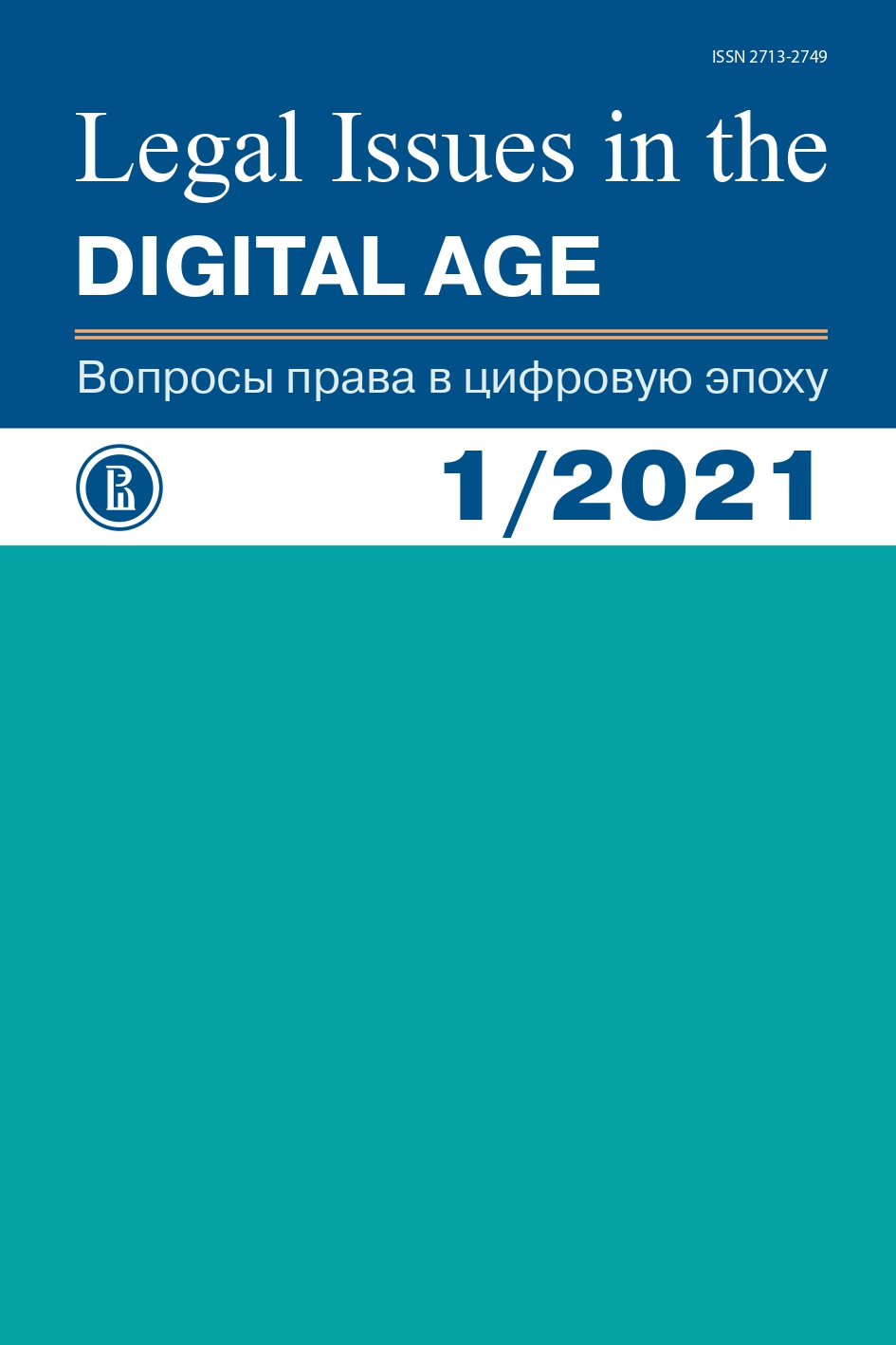Blockchain, Smart Contracts and Intellectual Property. Using distributed ledger technology to protect, license and enforce intellectual property rights
Abstract
For several years, almost everyone has been talking about blockchain. The underlying distributed ledger technology has become (in)famous as the technology behind cryptocurrencies such as Bitcoin and Ether. But what about blockchain and intellectual property like patents and copyright? Could this technology be used for the protection and enforcement of such rights? Which role can smart contracts play in this regard? This article focuses on questions concerning the requirements for provingthe protection of technical inventions as well as on the administration and exploitation of intellectual property rights. The latter could play an important rolefor intellectual property, which has not been registered or is not subject to registration, such as copyright. For trade secrets, a blockchain could be a useful tool for providing appropriate confidentiality measures. Last but not least, smart contracts in particular could be involved in connection with the transfer and, even more importantly, the licensing of intellectual property and mainly of software.
References
Allessie D. et al. (2019) Blockchain for digital government: An assessment of pioneering implementations in public services. In: Pignatelli F. (ed.) JRC Science for Policy Report. European Union. Available at: https://joinup.ec.europa.eu/sites/default/files/document/2019-04/JRC115049%20blockchain%20for%20digital%20government.pdf (accessed: 24 Feb 2021)
Blocher W., Hoppen A., Hoppen P. (2017) Softwarelizenzen auf der Blockchain. Computer und Recht, no 36, pp.337–348. DOI: https://doi.org/10.9785/cr-2017-0508
Chohan U. (2017) The Double Spending Problem and Cryptocurrencies. Available at: https://ssrn.com/abstract=3090174 (accessed: 24 Feb 2021) DOI: https://doi.org/10.2139/ssrn.3090174
Clark B. (2018) Blockchain and IP Law: A Match made in Crypto Heaven? Available at: https://www.wipo.int/wipo_magazine/en/2018/01/article_0005.html. (accessed: 24 Feb 2021)
Dob D. (2018) Permissioned vs Permissionless Blockchains: Understanding the Differences. Available at: https://blockonomi.com/permis-sioned-vs-permissionless-blockchains/ (accessed: 24 Feb 2021)
Finck M. (2019) Blockchain Regulation and Governance in Europe. Cambridge (Mass.): University Press, 255 p. DOI: https://doi.org/10.1017/9781108609708
Finck M., Moscon V. (2019) Copyright Law on Blockchains: Between New Forms of Rights Administration and Digital Rights Management 2.0. IIC, no 1, pp. 77–108. DOI: https://doi.org/10.1007/s40319-018-00776-8
Fulmer N. (2019) Exploring the Legal Issues of Blockchain Applications. Akron Law Review, vol. 52, pp. 161–192.
Gürkaynak G. et al. (2018) Intellectual property law and practice in the blockchain realm. Computer Law Security Review, vol. 34, pp. 847–862. DOI: https://doi.org/10.1016/j.clsr.2018.05.027
Hauck R. (2017) Der Erschöpfungsgrundsatz im Patent- und Urheberrecht, EuZW, vol. 28, pp. 645–649.
Hilty R. (2018) Kontrolle der digitalen Werknutzung zwischen Vertrag und Erschöpfung ́. GRUR, vol.120, pp. 865–880.
Hohn-Hein N., Barth G. (2018) Immaterialgüterrechte in der Welt von Blockchain und Smart Contract. GRUR, vol. 120, pp. 1089–1096.
Hoppen A., Hoppen P. (2018) License on Blockchain: Transferring and Managing Software Licenses on the Ethereum Blockchain, Version 1. Available at: https://github.com/license-on-blockchain/whitepaper/releases (accessed: 24 Feb 2021)
Kaulartz M., Heckmann J. (2016) Smart Contracts — Anwendungen der Blockchain-Technologie. ComputerundRecht, no 35, pp. 618–624.Kraßer R., Ann C. (2016) LehrbuchPatentrecht. 7th ed. Munich: Beck, Kuchta R. (2017) The hash — a computer file’s digital fingerprint. Available at: https://newtech.law/en/the-hash-a-computer-files-digital-fingerprint/(accessed: 24 Feb 2021) DOI: https://doi.org/10.9785/cr-2016-0923
Lauber-Rönsberg A., Hetmank S. (2019) The Concept of Authorship and Inventorship under Pressure: Does Artificial Intelligence Shift Paradigms? GRUR International no 4, pp. 641–647. DOI: https://doi.org/10.1093/jiplp/jpz061
McJohn S., McJohn I. (2016) The Commercial Law of Bitcoin and Blockchain Transactions. Legal Studies Research Paper no 16–13. Available at:https://papers.ssrn.com/sol3/papers.cfm?abstract_id=2874463 ( accessed: 24 Feb 2021)
Nakamoto S. (2008) Bitcoin: A Peer-to-Peer Electronic Cash System. Available at: https://bitcoin.org/bitcoin.pdf (accessed: 24 Feb 2021)
O’ShieldsR. (2017) Smart Contracts: Legal Agreements for the Blockchain. N.C. Banking Institute, no 21, pp. 177–194.
Pahlow L. (2017) Patentlizenz und Patentlizenzvertrag. In: Henn/Pahlow (eds.) Patentvertragsrecht. 6th ed. Heidelberg: C.F. Müller, 401 p.
Pilkington M. (2016) Blockchain Technology: Principles and Applications. In: Olleros F., Zhegu M. (eds.) Research Handbook on Digital Transformations. Cheltenam: Elgar, pp. 225–253. DOI: https://doi.org/10.4337/9781784717766.00019
Raskin M. (2017) The Law of Smart Contracts. Georgetown Law Technology Review, no 2, pp. 305–341. DOI: https://doi.org/10.2139/ssrn.2842258
Reinbothe J. (2015) Collective Rights Management in Germany. In: Gervais D. (ed.) Collective Management of Copyright and Related Rights. 3rd ed. The Hague: Kluwer Law International, pp. 215–250.
Rosenblatt B.(2019) Blockchain Applications for Music Enter the Bowling Alley. Available at: https://copyrightandtechnology.com/ 2019/06/15/blockchain-applications-for-music-enter-the-bowling-al-ley/ (accessed: 24 Feb 2021)
Ross E. (2017) Nobody Puts Blockchain In A Corner: The Disruptive Role of Blockchain Technology. Catholic University Journal of Law and Technology, vol. 25, pp. 353–386.
Sai Deepak J. (2010) The Elusive Quest for the Definition of Obvious-ness — Patent Law’s Holy Grail. IIC, no 4, pp. 410–427.
Salmon J., Myers G. (2017) Blockchain and Associated Legal Issues for Emerging Markets, EM Compass. Available at: https://www.ifc.org/wps/wcm/connect/da7da0dd-2068-4728-b846-7cffcd1fd24a/EMCom-pass-Note-63-Blockchain-and-Legal-Issues-in-Emerging-Markets.pdf?MOD=AJPERES&CVID=mxocw9F (accessed: 24 Feb 2021)
Schrey J., Thalhofer T. (2017) Rechtliche Aspekte der Blockchain. NJW,vol. 70, pp. 1431–1436.
Sergey I. (2018) Scilla: a Smart Contract Intermediate-Level Language. Available at: https://arxiv.org/pdf/1801.00687.pdf (accessed: 24 Feb 2021)
Szabo N. (1997) The Idea of smart contracts. Available at: http://www.fon.hum.uva.nl/rob/Courses/InformationInSpeech/CDROM/Literature/LOTwinterschool2006/szabo.best.vwh.net/idea.html (accessed: 24 Feb 2021)
Tapscott D., Tapscott A. (2016) The Blockchain Revolution: How the Technology Behind Bitcoin is Changing Money, Business, and the World. N.Y.: Random House
Walch A. (2017) The Path of the Blockchain Lexicon (and the Law). Review of Bank and Fin Law, vol. 36, pp. 713–765.
Yanisky-Ravid S., Kim E. (2019) Patenting Blockchain: Mitigating the Patent Infringement War. Available at: C:/Users/Juristische%20Fakultät/Downloads/SSRN-id3357350.pdf. (accessed: 24 Feb 2021)
Zurth P. (2020) Lizenzverträge und Lizenzen in der Insolvenz und Einzelzwangsvollstreckung. In: Obergfell E., Hauck R. (eds.) Lizenzvertragsrecht. 2nd ed. Berlin: De Guyter, pp. 183–225.
Authors who publish with this journal agree to the Licensing, Copyright, Open Access and Repository Policy.










